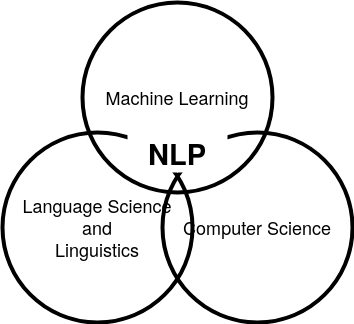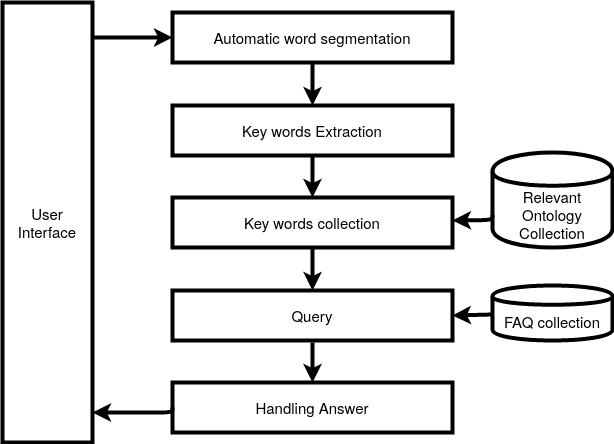Natural Language Processing#
Introduction#
A real tangible and still the most applied use case for machine learning is natural language processing (NLP). Many businesses use cases for machine learning are based on information. This can be input or processed information. In fact most business use cases that can benefit of machine learning have nothing to do with images or video. Most business do have information of customers in digital form available and want to use this data to develop more value added services for their customers.
Everything that has to do with text processing and involves machine learning can be categorized as Natural Language Processing (NLP).

NLP is concerned with programming computers to process natural language. NLP is at the intersection of computer science, machine learning and linguistics. The most innovative form of NLP are applications that use using the latest machine learning technologies to derive meaning from human languages. NLP is something that’s been part of our lives for decades. In fact, consumers from across the globe interact with NLP on a daily basis, without even realizing it. But with more FOSS machine learning building blocks available even with the latest machine learning algorithm, also NLP innovation is growing rapidly.
NLP technology is important for scientific, economic, social, and cultural reasons. Computers that can communicate with humans as humans do are a holy grail. Including understanding context and emotions. Due to infinite number of cultures solving this problem has proven to be hard. Communication is not only verbal. Nonverbal is the significant part of communication. Nonverbal communication is the nonlinguistic transmission of information through visual, auditory, tactile, and kinesthetic (physical) channels.
NLP is experiencing rapid growth as its theories and methods are deployed in a variety of new machine learning technologies.
More and more NLP techniques are used products that have serious impact on our daily lives. A misinterpreted pronounced word like ‘stop’ can have several meanings when used within an autonomous driving car. Maybe you just meant to warn your children instead of stopping the vehicle on a dangerous intersection.
Creating good NLP based applications using machine learning is hard. A simple test that gives an indication of the quality is to use a the sentence “Buffalo buffalo Buffalo buffalo buffalo buffalo Buffalo buffalo”. This sentence is correct. But many NLP algorithms and applications cannot handle this very well. Similar sentences exist in other languages. We humans are by nature good with complicated linguistic constructs, but many NLP algorithms still fail with this simple example. Some background information on this sentence can be found on Wikipedia (https://en.wikipedia.org/wiki/Buffalo_buffalo_Buffalo_buffalo_buffalo_buffalo_Buffalo_buffalo )
Basic NLP functions#
NLP is able to do all kinds of basic text functions. A short overview:
Text Classification (e.g. document categorization).
Finding words with the same meaning for search.
Understanding how much time it take to read a text.
Understanding how difficult it is to read is a text.
Identifying the language of a text.
Generating a summary of a text.
Finding similar documents.
Identifying entities (e.g., cities, people, locations) in a text.
Translating a text.
Text Generation.
Machine learning capabilities have proven to be very useful for improving typical NLP based use cases. This is due to the fact that text in digital format is widely available and machine learning algorithms typically perform good on large amounts of data.
NLP papers and NLP software comes with a typical terminology:
Tokenizer: Splitting the text into words or phrases.
Stemming and lemmatization. Normalizing words so that different forms map to the canonical word with the same meaning. For example, “running” and “ran” map to “run.”
Entity extraction: Identifying subjects in the text.
Part of speech detection: Identifying text as a verb, noun, participle, verb phrase, and so on.
Sentence boundary detection: Detecting complete sentences within paragraphs of text.
To create NLP enabled applications you need to set up a ‘pipeline’ for the various software building blocks. For each step in a NLP development pipeline another FOSS building block can be needed. The figure below shows a typical NLP pipeline.

In the figure below a typical NLP architecture for providing input on common user questions. A lot of Bot systems (Build–operate–transfer) or FAQ answering systems are created with no machine learning algorithms at all. Often simple keyword extraction is done and a simple match in a database is performed. More state-of-the-art NLP systems make intensive use of machine learning algorithms. The general rule is: If a application should be user friendly and value added than learning algorithms are needed, since it is no longer possible to program output based on given input.

NLP Business challenges#
When using NLP technology to extract information and insight from text, the starting point is typically the raw documents stored on websites, unstructured documents and structured documents. Also the fact that documents are stored in a variety of formats, like PDF, MSword, TIFFs make that the time needed before text can be send towards an algorithm long and often manual intensive. Even the most advanced web scraping techniques (software to store raw text of websites) is manual intensive. Unstructured text must be structured first before using these text for a NLP driven application is possible.
Privacy is a large concern when dealing with documents. To comply with the GDPR (in EU) using text with personal information of e.g. customers for other purposes is often not allowed without explicit permission of the owners of the personal data.
NLP Business Examples#
NLP enabled application make a good fit for businesses where analysing or processing text is done at large. Below some example NLP business use cases.
Social media monitoring:Almost all social media monitoring tools are basically built using NLP technology. These tools help to monitor social media channels for mentions of your brand, and alert you when consumers are talking about your brand. Real time monitoring of social media channels is important for companies for a lot of large companies, e.g. to ensure that any potential crises is noticed immediately.
Sentiment analysis: Sentiment analysis is a smaller subset of social media monitoring. It refers to monitoring the social media landscape and listening in on conversations and identifying opinions and determining whether the author of the post holds a positive, negative, or neutral opinion towards a brand. Using NLP sentiment analysis tools is it easy to filter emotionally-charged words that are used to describe a brand or a customer’s experience with a brand. It is also possible to automate research on how consumers speak about a product or service.
Text analysis: Text analysis can be broken into several sub-categories e.g. grammatical, syntactic and semantic analyses. By analysing text and extracting different types of key elements (such as topics, people, dates, locations, companies), it is easier to organize data and identify useful patterns and insights.
Survey analytics: If you are analysing large amounts of surveys you can use old-skool reporting and statistical techniques. But a NLP based analyse makes it possible to faster and easier find patterns, categories and anomalies that are hard to find manual in survey responses with more than 20.000 responses.
Spam filters: Emails that contain text and words such as “free”, “promotion”, “buy now” , ‘coin’ , ‘offer’ , etc, have a high chance of being spam. With the use of NLP technology you can create self learning spam filters. Sometimes too good.
Autocomplete: With an autocomplete function it is possible to predicts what the next characters or words will be that you will enter. This makes the use of text based UI simpler.
Hiring Tools: Large companies still do receive many resumes, analysing can be time-consuming and the task of sorting overwhelming. Natural language processing software is able to speed up the process of sorting resumes. But be aware NLP software is not flawless. So you will miss good candidates if you only scan resumes.
Conversational Search: Traditional search often brings not the results you want. Wit conversational search the context of your search is taken into account. So only for the current context relevant search items will be presented. Since searching quality information is time consuming , streamlining search in real-time conversation NLP software will improve productivity for knowledge workers.
